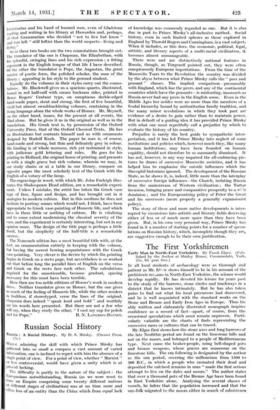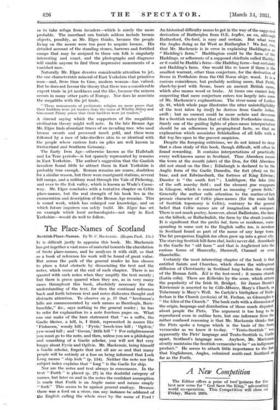The First Yorkshiremen
Early Man in North-East Yorkshire. By Frank Elgee. (Pub. fished by the Author at Shirley House, Cominondale, York. 25s. 9d. post free.) Is all local students of archaeology were as thorough and patient as Mr. Ei-le shows himself to be in his account of the prehistoric re: .ams in North-East Yorkshire, the science would develop rapidly. He has devoted his leisure for years past to the study of the barrows, stone circles and trackways in a district that he knows intimately. But he has also taken pains to find out what his local precursors had discovered, and he is well acquainted with the standard works on the Stone and Bronze and Early Iron Ages in Europe. Thus his ably written and elaborately illustrated monograph inspires confidence as a record of fact—apart, of course, from the occasional speculations which must remain unproven. Parti- cularly valuable are the charts of finds representing the successive races or cultures that can be traced.
Mr. Elgee first shows how the stone axes and long barrows of the late Neolithic period are found on the limestone hills and not on the moors, and belonged to a people of Mediterranean type. Next came the beaker-people, using bell-shaped pots and bronze weapons, whose graves are numerous on the limestone hills. The era following is designated by the author as the urn period, covering the millennium from 1500 to 500 B.C., in which a people who cremated their dead and deposited the calcined remains in urns " made the first serious attempt to live on the dales and moors." The author states that over a thousand pots of the Bronze Age have been found in East Yorkshire alone. Analysing the several classes of vessels, he infers that the population increased and that the urn-folk migrated to the moors either in search of subsistence or to take refuge from invaders—which is surely the more probable. The moorland urn burials seldom include bronze objects, possibly, as Mr. Elgee thinks, because the people living on the moors were too poor to acquire bronze. His detailed account of the standing stones, barrows and fortified camps that may be assigned to these urn folk is singularly interesting and exact, and the photographs and diagrams will enable anyone to find these impressive monuments of a vanished race.
Naturally Mr. Elgee devotes considerable attention to jet, the one characteristic mineral of East Yorkshire that primitive man—and, from time to time, modem woman—has valued. But he does not favour the theory that there was a considerable export trade in jet necklaces and the like, because the minera occurs in many other parts of Europe. Nor does he associate the megaliths with the jet trade.
" These monuments of prehistoric religion no more prove that their builders were jet traders than the ruins of Whitby Abbey and Grosmont Priory prove that their builders were jet traders."
A shrewd saying which the supporters of the megalithic civilisation theory might well note. In the late Bronze Age Mr. Elgee finds abundant traces of an invading race who used bronze swords and possessed much gold, and these were followed by a race of lake-dwellers akin to or identical with the people whose curious huts on piles are well known in Switzerland and Southern Germany.
The Early Iron Age—otherwise known as the Hallstadt and La Tene periods—is but sparsely represented by remains in East Yorkshire. The author's suggestion that the Gaulish invaders found little to attract them in East Yorkshire is probably true enough. Roman remains are scarce, doubtless for a similar reason, but there were coastguard stations, several hill camps, and a military road through the Vale of Pickering, and over to the Esk valley, which is known as Wade's Cause- way. Mr. Elgee concludes with a tentative chapter on Celtic place-names, but the real strength of his book lies in the enumeration and description of the Bronze Age remains. This -is sound work, which has enlarged our knowledge, and on which future inquirers can safely build. Mr. Elgee has set an example which local archaeologists—not only in East Yorkshire—would do well to follow.
























































 Previous page
Previous page